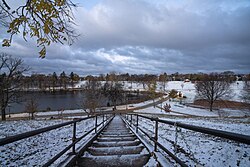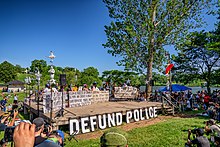This article is about a park. For the neighborhood, see Powderhorn Park, Minneapolis.
| Powderhorn Park | |
|---|---|
 Powderhorn Park in November 2021 Powderhorn Park in November 2021 | |
| Type | Urban park |
| Location | Powderhorn Park, Minneapolis, Minnesota |
| Coordinates | 44°56′23″N 93°15′12″W / 44.93972°N 93.25333°W / 44.93972; -93.25333 |
| Area | 65.9 acres (26.7 ha) |
| Established | 1887; 138 years ago (1887) |
| Operated by | Minneapolis Park and Recreation Board |
| Open | 6 am-10 pm, year-round |
| Water | Powderhorn Lake |
Powderhorn Park is an urban park in Minneapolis. It sits in the northwest of the Powderhorn Park neighborhood and near the center of the larger Powderhorn community, both of which take their names from the park. The park was established around Powderhorn Lake in the late 19th century.
The park is mostly set at an elevation below the surrounding neighborhood. It contains playing fields, playgrounds and a recreation center that hosts community education classes ranging from pottery to yoga. In winter, the Minneapolis Park and Recreation Board sets up a portable warming house and the lake is used for ice skating. Powderhorn Lake is a popular local destination for shore or pier fishing.
History

Before there was a park, there was a curved lake in the middle of what is now Minneapolis. The name Powderhorn Lake was first used for the lake in a map of the area around Fort Snelling in 1839. The lake takes its name from its former shape: it was curved, resembling a powder horn, until the mid-1920s, when the northern arm of the lake was filled. The lake is still at the center of the park; the former northern arm now hosts a baseball diamond.
The park was established in the 1880s as the surrounding area was beginning to fill in with housing. In 1883, the Minnesota Legislature and Minneapolis voters approved the founding of the Minneapolis Park and Recreation Board (MPRB), and within months, residents of the area asking for a park around Powderhorn Lake. MPRB designated the lake shore as a park in 1887, then embarked in a slow period of land acquisitions. A 20-acre plot was added in 1891. The ice rink was constructed that year and the recreation center built in 1907. By 1917, the park was shaped almost the same as it is today.
Events
Annual and reoccurring

The park and lake are used as the setting for the last act in the city's annual May Day parade (occurring on the first Sunday in May), which is a play in motion that has been running since 1975. This was produced by the In the Heart of the Beast Puppet and Mask Theatre through 2022 and continues as a decentralized, community-run endeavor. As the parade runs south along Bloomington Avenue, participants wear a variety of costumes, and many manipulate giant puppets, all to produce a story that is based on sociopolitical themes including peace, environmentalism, current events, and others. After the parade story ends, the tail end of the parade is a "free speech" section which includes representatives of community groups and campaigning politicians. After the parade, people gather on a hillside at the west end of the park for the Tree of Life ceremony. Many details of the final act change from year to year, but there are several figures that consistently appear: River, Woods, Prairie, Sky, Sun, and the Tree of Life. At the end of the ceremony, a flotilla comes across the lake with the Sun figure in the central boat. The Sun awakens the Tree of Life (a figure which includes a traditional maypole), and the crowd sings "You Are My Sunshine" to mark the banishment of another season of winter.
Powderhorn Park is also home to other festivals and decentralized celebrations. The Powderhorn Art Fair, a fine arts and crafts festival, has been held in the park for over 30 years. The park has also hosted the Autonomous Zine Fest. Minneapolis People's Pride, an LGBT pride festival designed to be free of police and corporate presences, has been located in the park since 2021. The Minneapolis Art Sled Rally, an event in which participants sled down the hill in sleds of their own design, often depicting topical characters or themes, has been in Powderhorn Park since 2008. The rally has made the news for its creative and sometimes controversial sled designs.
Protests and civil unrest

Powderhorn Park has been a gathering site for protests, including as part of the Black Lives Matter movement. In June 2020, shortly after the Murder of George Floyd, crowds of hundreds gathered in the park to protest the murder and the call for a stronger response from city leadership. There, nine of the thirteen members of the Minneapolis City Council pledged to dismantle the Minneapolis Police Department.
An encampment for people experiencing homelessness emerged at Powderhorn Park in mid 2020 as a result of civil disorder in the aftermath of Floyd's murder. Some community members complained about the camp (which brought increased vehicle traffic, drugs, property damage, and at least two overdoses) and changed their behavior to avoid it, and others committed to not involving the police. Some community members delivered meals, medical care, and counseling and sought support from the American Indian Movement to monitor the area. The Powderhorn Park encampment was considered the largest in the history of the Twin Cities metropolitan history, having 560 tents with an estimated 800 people living it by mid July 2020.
See also
References
- Powderhorn Park, Minneapolis, MN. Google Earth. Retrieved 2011-03-09.
- "Powderhorn Park". Minneapolis Park and Recreation Board. Retrieved May 13, 2024.
- Jones, Grace. "Powderhorn Park". A Field Guide to Public Spaces. Retrieved May 13, 2024.
- "Powderhorn Lake". Minnesota Department of Natural Resources. Retrieved May 13, 2024.
- ^ Abbott, E.T.; Abbott, W. S. M.; Hart, Charles H. (1880). "(Cartographic) Abbott's Map of the City of Minneapolis, Hennepin County, Minn". Hennepin County Library, James K. Hosmer Special Collections Library. Retrieved May 13, 2024.
- ^ Smith, David C; Minneapolis Park and Recreation Board. "Powderhorn Park: History". Minneapolis Park and Recreation Board. Retrieved April 19, 2024.
- Bennett, Edward H. (Edward Herbert), 1874-1954. "(Cartographic) 1917 General Plan Minneapolis Minnesota showing complete street and park system prepared for the Civic Commission Of Minneapolis,(1917)". Hennepin County Library, James K. Hosmer Special Collections Library. Retrieved May 13, 2024.
{{cite web}}: CS1 maint: multiple names: authors list (link) CS1 maint: numeric names: authors list (link) - "MayDay Released". In the Heart of the Beast Puppet and Mask Theatre. 2023. Retrieved April 19, 2024.
- Maya, Cynthia (June 15, 2022). "Minnesota's Summer Art Fairs". Mpls. St. Paul. Key Enterprises. Archived from the original on May 13, 2023. Retrieved May 13, 2023.
- Valelly, Jonathan. "Zine Fests Put to the Test". Broken Pencil. No. 93. Retrieved May 13, 2024.
- Haan, Sofia (June 1, 2023). "Where to celebrate Pride in the Twin Cities". The Current. Minnesota Public Radio. Retrieved May 13, 2024.
- "An Alternative Pride Celebration". Minneapolis People's Pride. Retrieved May 13, 2024.
- Baichtal, John (February 18, 2009). "Riding the Snow in Style at the Minneapolis Art Sled Rally". Wired. Retrieved May 13, 2024.
- Yang, Pafoua (January 29, 2024). "Creator of controversial art sled says burning of Minneapolis police precinct was a 'good thing'". KSTP. Retrieved May 13, 2024.
- Du, Susan; Cassel, Emily; Jones, Hannah (July 1, 2020). "Defund & dismantle: Minneapolis looks toward a police-free future". City Pages. Archived from the original on December 13, 2020.
- Searcey, Dionne; Eligon, John (June 7, 2020). "Minneapolis Will Dismantle Its Police Force, Council Members Pledge". The New York Times. Archived from the original on June 8, 2020. Retrieved June 8, 2020.
- ^ Dickerson, Caitlin (June 24, 2020). "A Minneapolis Neighborhood Vowed to Check Its Privilege. It's Already Being Tested". The New York Times.
- Rosengren, John (December 13, 2020). "In a Tumultuous Year, COVID Puts Homeless Crisis Front and Center". MplsStPaul.
| City of Minneapolis | |
|---|---|
| Topics | |